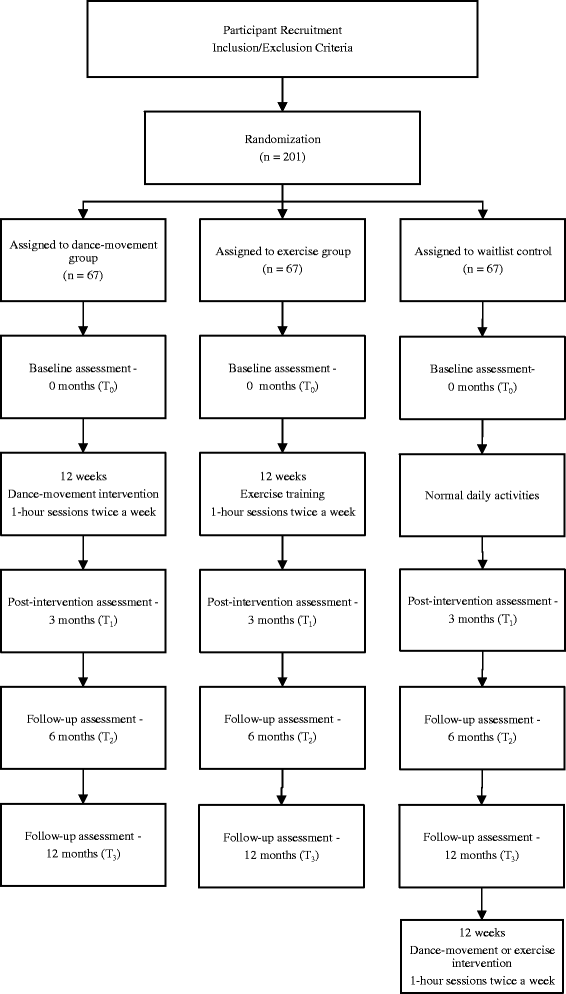A 3-arm randomized controlled trial on the effects of dance movement intervention and exercises on elderly with early dementia
- PMID: 26481870
- PMCID: PMC4615324
- DOI: 10.1186/s12877-015-0123-z
A 3-arm randomized controlled trial on the effects of dance movement intervention and exercises on elderly with early dementia
Abstract
Background: Dementia is characterized by a progressive decline and deterioration of brain regions such as memory, spatial navigation and language, along with disturbances in daily functioning. Non-pharmacological interventions that offer a holistic approach by targeting cognitive functioning, prognosis and the psychological and social effects of dementia require rigorous investigation. The well-established benefits of physical activity for cognitive functioning and psychological support in dementia have been observed with dance-movement intervention. There is substantial evidence that dance-movement interventions provide emotional and social advantages. Thus, a randomized controlled trial (RCT) is planned to investigate the positive effects of a dance movement intervention, compared with mild physical exercise, on the physical and psychological well-being of elderly Chinese individuals with early dementia.
Methods/design: A 3-arm RCT with waitlist control design will be used in this study. Two hundred and one elderly participants with very mild to mild dementia will be screened and randomized into the following groups: (i) dance movement based intervention, (ii) stretching and exercise intervention and (iii) no intervention waitlist-control group. The two intervention groups will receive a 1-h intervention, twice a week, for 12 weeks. The participants will be assessed four times over the course of 12 months: baseline before randomization, post-intervention (3 months), 6 months from baseline and 12 months from baseline. The primary outcomes will be compared between assessment points and between groups on neuropsychiatric symptoms, psychosocial well-being and cognitive and daily functioning. Secondary outcomes will assess the changes in salivary cortisol levels and their relationships with the primary outcome measures.
Discussion: This study will provide substantial evidence of the efficacy of a dance-movement-based intervention in slowing down dementia progression, due to its ability to act as a buffer against decline and improve areas affected by dementia. We also anticipate an association between cortisol levels and the outcome measures. The further development of this intervention into a structural program may be warranted for early psychosocial support among elderly populations.
Trial registration: The trial has been registered in the Chinese Clinical Trial Registry ( ChiCTR-IOR-15006541 ).
Figures

Similar articles
-
The effect of an interactive cycling training on cognitive functioning in older adults with mild dementia: study protocol for a randomized controlled trial.BMC Geriatr. 2017 Mar 21;17(1):73. doi: 10.1186/s12877-017-0464-x. BMC Geriatr. 2017. PMID: 28327083 Free PMC article. Clinical Trial.
-
Psychophysiological Effects of Dance Movement Therapy and Physical Exercise on Older Adults With Mild Dementia: A Randomized Controlled Trial.J Gerontol B Psychol Sci Soc Sci. 2020 Feb 14;75(3):560-570. doi: 10.1093/geronb/gby145. J Gerontol B Psychol Sci Soc Sci. 2020. PMID: 30496547 Clinical Trial.
-
The effects of an extensive exercise programme on the progression of Mild Cognitive Impairment (MCI): study protocol for a randomised controlled trial.BMC Geriatr. 2017 Mar 22;17(1):75. doi: 10.1186/s12877-017-0457-9. BMC Geriatr. 2017. PMID: 28330458 Free PMC article. Clinical Trial.
-
Interpersonal synchrony in dance/movement therapy: Neural underpinnings for individuals with dementia.J Alzheimers Dis. 2025 Jun;105(4):1143-1147. doi: 10.3233/JAD-240239. Epub 2025 Mar 17. J Alzheimers Dis. 2025. PMID: 39093071 Review.
-
Effects of physical activity on delayed memory measures in randomized controlled trials with nonclinical older, mild cognitive impairment, and dementia participants.J Clin Exp Neuropsychol. 2018 Nov;40(9):874-886. doi: 10.1080/13803395.2018.1442815. Epub 2018 Mar 6. J Clin Exp Neuropsychol. 2018. PMID: 29510648 Review.
Cited by
-
Effects of exercise interventions on cognitive function in patients with cognitive dysfunction: an umbrella review of meta-analyses.Front Aging Neurosci. 2025 May 16;17:1553868. doi: 10.3389/fnagi.2025.1553868. eCollection 2025. Front Aging Neurosci. 2025. PMID: 40454205 Free PMC article.
-
The Beneficial Effect of Physical Exercise on Cognitive Function in a Non-dementia Aging Chinese Population.Front Aging Neurosci. 2019 Aug 29;11:238. doi: 10.3389/fnagi.2019.00238. eCollection 2019. Front Aging Neurosci. 2019. PMID: 31555125 Free PMC article.
-
Dance movement therapy for dementia.Cochrane Database Syst Rev. 2017 Feb 3;2(2):CD011022. doi: 10.1002/14651858.CD011022.pub2. Cochrane Database Syst Rev. 2017. Update in: Cochrane Database Syst Rev. 2023 Aug 7;8:CD011022. doi: 10.1002/14651858.CD011022.pub3. PMID: 28155990 Free PMC article. Updated.
-
Dance intervention effects on physical function in healthy older adults: a systematic review and meta-analysis.Aging Clin Exp Res. 2021 Feb;33(2):253-263. doi: 10.1007/s40520-019-01440-y. Epub 2020 Jan 1. Aging Clin Exp Res. 2021. PMID: 31894561
-
Use of the Tokyo Cognitive Assessment for mild cognitive impairment to characterize elderly people that use day care services in Japan.J Phys Ther Sci. 2022 Aug;34(8):577-583. doi: 10.1589/jpts.34.577. Epub 2022 Aug 3. J Phys Ther Sci. 2022. PMID: 35937627 Free PMC article.
References
-
- Hamill M, Smith L, Rohricht F. ‘Dancing down memory lane’: circle dancing as a psychotherapeutic intervention in dementia - a pilot study. Dementia. 2011;11(6):709–24. doi: 10.1177/1471301211420509. - DOI
-
- Lyketsos CG, Steinberg M, Tschanz JT, Norton MC, Steffens DC, Breitner JC. Mental and behavioral disturbances in dementia: findings from the Cache County Study on Memory in Aging. Am J Psychiatry. 2000;157:708-14. - PubMed
Publication types
MeSH terms
Substances
LinkOut - more resources
Full Text Sources
Other Literature Sources
Medical
Miscellaneous

